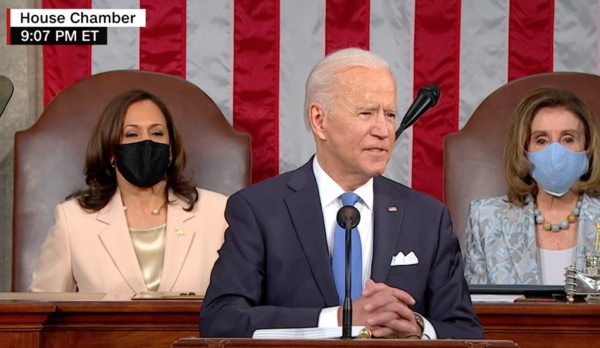President Biden’s New Medicare and Medicaid Chief can be a Champion for Older Women

It’s a historic week for Medicare and Medicaid – and for American women. On Tuesday, the Senate confirmed Chiquita Brooks-LaSure as the new administrator of the Centers for Medicare and Medicaid Services (CMS). She becomes the first Black woman to head the agency that administers health care for more than 100 million Americans, including and especially seniors.
This is a milestone for women striving for greater retirement security, because retirement security depends on access to affordable, quality health care. Brooks-LaSure, who served as a health care policy official under President Obama, will bring a lifetime of experience and perspective to her role. Who better to lead CMS at a time when all women, but especially women of color, lag behind men in retirement security? (Visit Eleanor’s Hope for more information on gender equity issues affecting working and retired women.)
Brooks-LaSure represents a welcome change of direction for CMS. She replaces President Trump’s CMS chief, Seema Verma, who left the job when Joe Biden was inaugurated on January 20th. Verma – a corporatist conservative idealogue – spent four years undermining traditional Medicare, Medicaid, and the Affordable Care Act. She was anything but an ally for older women.
By comparison, Brooks-LaSure was “championed by allies on Capitol Hill, including the Congressional Black Caucus,” according to the Washington Post. She no doubt will be a powerful advocate for President Biden’s legislative efforts to boost health care access – especially for older Americans. President Biden campaigned on a platform of expanding not only Medicaid, but Medicare – a key goal for the National Committee and our members and supporters across the country.
These programs are crucial to the retirement security of millions of women. Nearly 60 percent of low-income seniors who receive Medicaid benefits are women. Older women depend on Medicaid more than older men because they have a longer life expectancy, less income, higher poverty rates and multiple chronic conditions that require long-term services.
The Affordable Care Act (ACA) allowed states to greatly expand Medicaid coverage, which also benefitted women with incomes below 138% of the federal poverty line. In expanding Medicaid, the ACA extended a health care lifeline to women of color, single mothers, and women without a high school degree who may not have previously qualified for benefits.
Medicare is another crucial program that can benefit from LaSure’s leadership. The Kaiser Family Foundation calls it “a critical source of health insurance coverage for virtually all older women in the U.S.”
“Medicare helps to make health care more affordable for older women at a time in their lives when they are most likely to have multiple health problems that require ongoing and often costly medical treatment. Today, one in five adult women relies on Medicare for basic health insurance protection. In fact, women comprise 57% of the Medicare population.” – Kaiser Family Foundation
President Biden’s new Medicare and Medicaid administrator no doubt will work to strengthen the two programs – along with the Affordable Care Act – after four years of Trump administration attempts to weaken them. President Trump proposed cutting Medicare and Medicaid by over $1 trillion dollars in successive White House budget blueprints. His administration, under CMS chief Verma, encouraged states to impose work requirements on low-income Medicaid beneficiaries – and promoted private Medicare Advantage plans over traditional Medicare.
Brooks-LaSure no doubt will be a key player in the administration’s efforts to strengthen and expand Medicare and Medicaid. There is much work to be done, including adding hearing, vision, and dental benefits to traditional Medicare, and lowering prescription drug prices that sometimes force seniors to choose between paying the rent or paying for medicine. The appointment of Brooks-LaSure does not ensure instant progress – but it’s a meaningful start. After four years of enduring an antagonist in the CMS director’s chair, older women will finally have a champion.
Congress Must Not Forget Social Security
As Congress heads home for a three-week recess, the National Committee wants Senate and House members to remember that Social Security must be put on a sound financial footing for the future – without benefit cuts. In a wide-ranging interview with radio host T.J. Trout on KKOB, Albuquerque, our president and CEO, Max Richtman, laid out the case for preserving the program that keeps retirees, workers with disabilities, and their families out of poverty. Here are highlights from that interview:
The Future of the Social Security Trust Fund
Right now, if Congress takes no action, the Social Security Trust Fund will run out of money in 2035, which is not that far away. That does not mean that Social Security is ‘bankrupt’ if Congress does nothing, but benefits will be reduced by about 20%. We can’t let that happen.
There are proposals in Congress that we endorse and support (most prominently, Rep. John Larson’s Social Security 2100 Act) that would extend solvency many decades beyond 2035. In order to do that, the Social Security payroll wage cap will have to be adjusted.
The current cap is $142,800 annual wages. After that, there’s no payroll tax for high earners. Why? We have endorsed adjusting the cap so that annual wages exceeding $400,000 also are subject to the payroll tax. This would be consistent with President’s Biden’s pledge not to raise taxes on anyone earning less than $400,000 per year.
It’s Been Nearly Thirty Years Since Social Security was Overhauled
The last time Congress dealt with Social Security was in 1983. At that time, we were not looking at an insolvency timeline of 14 years. We were looking at six months. Congress enacted changes spread out over a long period of time, which put the program on solid financial ground for several decades. This time, we shouldn’t wait until we have six months left and the situation is drastic. We need to take action much sooner.
Public Opposes Benefit Cuts
Hopefully, there will be an effort in Congress to have some bipartisan support for proposals to bring more revenue into Social Security, instead of reducing benefits. Public opinion surveys indicate that large majorities of Americans oppose benefit cuts. Hopefully, during this recess, members of Congress will hear from their constituents directly.
There’s no immediate crisis. There’s no looming bankruptcy. But 10,000 people are turning 65 every day. We project that the number of seniors will grow by more than 40 million in next ten years. And the population of people 85 and older will triple by 2050. These seniors will depend on Social Security even more than today’s do. Constituents should go to town hall meetings, and demand that their Senators and Representatives take this issue seriously.
Raising the Retirement Age is a Benefit Cut
We adamantly oppose raising the Social Security eligibility age. A later eligibility age means a reduction in lifetime benefits. We have already raised the age from 65 to 67 in the amendments that passed in 1983. We don’t need to cut benefits by raising the age again. I often hear, “But people are living longer!” That doesn’t mean they can work longer. That doesn’t mean there are jobs for them. It’s a benefit cut.
Social Security is There for Younger Adults, Too
I’d like to send a message to the younger people in your audience. Naturally, younger people care about their aging parents and grandparents having financial security. But what is often overlooked is that one-third of Social Security benefits go to non-retired individuals – including spouses, survivors, workers with disabilities, and some four million children.
In fact, if you are a 27 year-old worker with a spouse and two children, you have about $500,000-worth of life and disability insurance through Social Security. That’s why the payroll deduction on your paycheck is labeled “FICA.” It stands for Federal Insurance Contribution Act. Social Security is an insurance program for workers of all ages. It’s not just seniors who have a stake in this. It’s everybody.
What about Privatizing Social Security?
We’re opposed to privatization. The last major attempt to privatize Social Security was promulgated by President George W. Bush. The day after Bush was re-elected in 2004, he said, “I have earned political capital and I’m going to spend it on privatizing Social Security.” We practically fell out of our chairs. He embarked on a tour of the country. We followed him the best we could, spreading the message that privatization was a terrible idea. We succeeded in killing that proposal. If he had succeeded, then in 2008 when the markets crashed, any privatized Social Security accounts would have been decimated, just like 401ks. We don’t want that to happen to a stable program that has kept more Americans out of poverty than all federal programs combined.
Click here to listen to Max Richtman’s entire interview on KKOB radio.
Giving Thanks to Seniors During Older Americans Month



In this space, we normally talk about the challenges that seniors face and the solutions we fight for. But Older Americans Month 2021, with its theme “Communities of Strength,” presents an opportunity to switch emphasis – and talk about the strength of seniors and the contributions they make to communities everywhere.
Seniors have always been a positive force in society, as parents, grandparents, volunteers, mentors, and workers. The pandemic only strengthened that role, even as it took a heavy toll on seniors themselves. To that extent, their stepped-up participation in our lives is nothing short of heroic.
Even before the pandemic, grandparents were taking on greater responsibility for raising grandchildren. According to Kiplinger, the number of children in their grandparents’ care doubled from 1970 to 2010. In 2019, some 2.5 million grandparents were responsible for raising their grandkids. And those are only the ones who do so ‘officially.’
During the pandemic, working parents lacking sufficient child-care have turned to grandparents to help out with the children. Grandparents have admirably stepped in to do everything from babysitting to home schooling to preparing meals for the family.
“Whether students are learning at school or at home, or are not yet school age, more grandparents have jumped into daily caregiver roles. Many are happily working without pay, for the love of family, while others have accepted offers of money from their frazzled, eternally grateful adult children.” – WTTG-TV, Washington, D.C.
During the height of the pandemic, Bill and Mary Hill of Phoenix, Arizona took care of their 8 year-old grandson five days a week, and supervised his homeschooling, because the child’s parents were required to show up for work in person.
“At first it was like, we’d love to be a part of this and get to see our grandson more, really get to know him a little better,” Mary said. “At the same time, we were going, `Oh my gosh.’ We knew it would change our lives and it has. It’s much busier.” – Mary Hill, Phoenix, AZ via Fox5 D.C.
There are two-way benefits in these arrangements. Grandchildren and parents get much-needed extra help – and seniors’ mental and physical health is often strengthened through social stimulation and enhanced activity.
Some of the extra help that seniors provide their families may not have been possible without their earned benefits – Social Security and Medicare. The basic financial and health security that these programs provide give seniors the flexibility and peace of mind to contribute to their families and communities.
Jeanne Trimble of Northern Virginia told the Wall Street Journal that her Social Security benefits made it possible for her to retire and care for her son’s two young children during the pandemic.
“My son and daughter-in-law were reluctant to put the kids in daycare and were struggling to keep up with their own work schedules. I’m 64 and was planning to retire in two years but my husband and I consulted with our bank and figured out that with Social Security, I could retire early to help out.” – Jeanne Trimble, Northern Virginia, in the Wall St. Journal
Helping out with grandchildren is only one of the many ways that seniors aid their communities. The Front Royal, VA Royal Examiner published a list of the myriad contributions that older Americans make to society, including:
- As caregivers for an ailing spouse, with responsibilities ranging from managing household tasks to offering emotional support and providing medical care.
- As babysitters for their grandchildren, whose parents are productive members of the workforce.
- As organizers for events hosted by religious groups and other types of community-based organizations, which often struggle to attract younger participants.
- As donators of time and money to charities, foundations, and non-profit organizations that support members of the community.
- As mentors for the next generation, passing on family legacies, a lifetime of experience, and a career’s worth of knowledge.
- As part of a support system for other seniors, such as by planning activities at their seniors’ residence or running errands for someone with reduced mobility.
One specialist in senior services summed it up nicely:
“Seniors are able to devote the required time and effort to see projects through from start to finish. Seniors realize their needs can be intergenerational and what benefits them will also benefit the rest of society.” – Mickey Balas, Seniors Navigator



Southern California senior Cliff Adcock volunteered for Meals on Wheels
This is what we mean when we say that seniors contribute so much to our lives and communities. The reason we repeat it often is that some in government and the private sector suggest that seniors receive too much help, or can afford to sacrifice some of their hard-earned, already modest benefits for the cause of fiscal austerity. We say, if anything, Social Security and Medicare must be strengthened and expanded. As seniors continue to give back so much, we must always look out for them in return.
April Jobs Report Proves Jobs Plan Really Needed



April’s disappointing jobs report serves as a reminder that President Biden’s American Jobs Plan remains not only relevant – but necessary. “We can’t let up, this jobs report makes that clear. We’ve got too much work to do,” said the President today, urging the enactment of his economic agenda.
The US economy added only 266,000 jobs in April on the anniversary of the worst job loss for any month on record. That was far less than forecasts of economists, who had predicted America would add 1 million jobs last month. – CNN, 5/7/21
Biden’s American Jobs plan would provide well-paying jobs for Americans to rebuild the nation’s infrastructure, which the President defined more broadly than just tunnels, roads, and bridges. He proposes to spend $400 billion alone on the caregiving infrastructure for seniors – with an emphasis on home and community-based care. The American Jobs Plan aims to provide high-quality jobs for caregivers for seniors in their homes and communities. Many of these workers are women of color, who have suffered the most during the COVID recession.
Lower-income earners, women, Hispanic and Black workers bore the brunt of the pandemic layoffs and millions remain out of work. Yet some industries can’t find workers. That may seem contradictory, but it is proof that the job market is changing under the force of the pandemic. – CNN, 5/7/21
In his plan, the President has made sure not to leave these and other non-college educated workers behind.
“An infrastructure program would create 8 million jobs for workers with a high school diploma or less, 4.8 million jobs for workers with more than a high school diploma but less than a bachelor’s degree, and 2.25 million jobs for workers with bachelor’s degrees and above.” – Georgetown University Center on Education and the Workforce
The American Jobs Plan would boost employment – and pay – for workers at all levels of education. This not only helps Americans put food on the table as the country recovers from the pandemic, but it swells the rolls of workers contributing to Social Security. More revenue rolling into the Social Security trust fund can improve the program’s financial health.
“Since wage-earners contribute to Social Security with every paycheck, the revenue generated from these new jobs would significantly extend the solvency of the trust fund, currently projected to be depleted in 2035. Not only would the program’s overall outlook brighten, workers could be eligible for higher Social Security benefits when they retire.” – Max Richtman, president and CEO, National Committee to Preserve Social Security and Medicare
The April jobs numbers need not be a reason for panic. Economists and pundits may have been overly optimistic about the unemployment picture for last month, leading to disappointment over the actual results. It clearly will take more time for the economy to fully recover. As President Biden said today, the recovery from COVID will be “a marathon, not a sprint.” The President’s American Jobs plan can inject a lot of new energy into the race toward recovery, while improving the livelihoods of current and future retirees.
Biden’s Speech: President Calls for Prescription Drug Price Reform, Defers White House Action



Seniors had their moment in the sun when President Biden unveiled his first infrastructure plan earlier this month. (The American Jobs Plan included an impressive $400 billion for improving senior care.) His new American Families Plan — dubbed “social infrastructure” by some — has less to offer seniors, focusing more on children and families. It includes more generous Affordable Care Act subsidies to help Americans afford Obamacare premiums, which would help near seniors (55-64) who are too young for Medicare. But the new plan does not include action on a crucial issue to older Americans: lowering the soaring cost of prescription drugs.
In his speech last night to a joint session of Congress, the President did make note of the prescription drug pricing issue:
“We all know how outrageously expensive drugs are in America. In fact, we pay the highest prescription drug prices of anywhere in the world right here in America… Let’s do what we talked about for all the years I was in Congress. Let’s give Medicare the power to save hundreds of billions of dollars by negotiating lower drug prescription prices.” – President Biden, 4/28/21
His acknowledgement and affirmation of the issue is important. Allowing Medicare to negotiate drug prices with Big Pharma is at the top of the list for Progressive Democrats and seniors’ advocates alike when it comes to drug pricing reform. But the White House has offered no specific plan.
Meanwhile, House Democrats have re-introduced the Elijah Cummings Lower Drug Costs Now Act (H.R. 3), which the Congressional Budget Office estimated would save the government some $400 billion in drug costs over ten years. (It also would expand Medicare to include coverage for basic hearing, vision, and dental care – a longtime priority for the National Committee and other seniors’ advocates.)
Advocates are understandably disappointed that the White House will not be pushing for prescription drug legislation right away. Exorbitant drug prices have a real impact on seniors living on fixed incomes, who cannot afford ever-rising costs at the pharmacy counter. According to Human Rights Watch:
Nearly 30 percent of adults in the US had not taken prescribed medication as recommended in the past year because of the cost. Instead of refilling expensive prescriptions, people skip doses or cut pills in half. – Human Rights Watch, 4/26/21
Skipping medications takes a staggering human toll. A 2020 study by West Health Policy Center estimated that the inability to fill prescriptions due to cost will result in 1.1 million premature deaths among Medicare beneficiaries over the next 10 years. That is an unacceptable result of Big Pharma price gouging.
The National Committee hopes that Congress can come together to support the inclusion of price negotiation in their version of the American Families Plan — and that they will respond to the desperate need for hearing, vision and dental services for seniors as part of traditional Medicare coverage. Seniors are an important part of the American family. They deserve our continued attention in this push to improve the nation’s “social infrastructure.”
President Biden’s New Medicare and Medicaid Chief can be a Champion for Older Women



It’s a historic week for Medicare and Medicaid – and for American women. On Tuesday, the Senate confirmed Chiquita Brooks-LaSure as the new administrator of the Centers for Medicare and Medicaid Services (CMS). She becomes the first Black woman to head the agency that administers health care for more than 100 million Americans, including and especially seniors.
This is a milestone for women striving for greater retirement security, because retirement security depends on access to affordable, quality health care. Brooks-LaSure, who served as a health care policy official under President Obama, will bring a lifetime of experience and perspective to her role. Who better to lead CMS at a time when all women, but especially women of color, lag behind men in retirement security? (Visit Eleanor’s Hope for more information on gender equity issues affecting working and retired women.)
Brooks-LaSure represents a welcome change of direction for CMS. She replaces President Trump’s CMS chief, Seema Verma, who left the job when Joe Biden was inaugurated on January 20th. Verma – a corporatist conservative idealogue – spent four years undermining traditional Medicare, Medicaid, and the Affordable Care Act. She was anything but an ally for older women.
By comparison, Brooks-LaSure was “championed by allies on Capitol Hill, including the Congressional Black Caucus,” according to the Washington Post. She no doubt will be a powerful advocate for President Biden’s legislative efforts to boost health care access – especially for older Americans. President Biden campaigned on a platform of expanding not only Medicaid, but Medicare – a key goal for the National Committee and our members and supporters across the country.
These programs are crucial to the retirement security of millions of women. Nearly 60 percent of low-income seniors who receive Medicaid benefits are women. Older women depend on Medicaid more than older men because they have a longer life expectancy, less income, higher poverty rates and multiple chronic conditions that require long-term services.
The Affordable Care Act (ACA) allowed states to greatly expand Medicaid coverage, which also benefitted women with incomes below 138% of the federal poverty line. In expanding Medicaid, the ACA extended a health care lifeline to women of color, single mothers, and women without a high school degree who may not have previously qualified for benefits.
Medicare is another crucial program that can benefit from LaSure’s leadership. The Kaiser Family Foundation calls it “a critical source of health insurance coverage for virtually all older women in the U.S.”
“Medicare helps to make health care more affordable for older women at a time in their lives when they are most likely to have multiple health problems that require ongoing and often costly medical treatment. Today, one in five adult women relies on Medicare for basic health insurance protection. In fact, women comprise 57% of the Medicare population.” – Kaiser Family Foundation
President Biden’s new Medicare and Medicaid administrator no doubt will work to strengthen the two programs – along with the Affordable Care Act – after four years of Trump administration attempts to weaken them. President Trump proposed cutting Medicare and Medicaid by over $1 trillion dollars in successive White House budget blueprints. His administration, under CMS chief Verma, encouraged states to impose work requirements on low-income Medicaid beneficiaries – and promoted private Medicare Advantage plans over traditional Medicare.
Brooks-LaSure no doubt will be a key player in the administration’s efforts to strengthen and expand Medicare and Medicaid. There is much work to be done, including adding hearing, vision, and dental benefits to traditional Medicare, and lowering prescription drug prices that sometimes force seniors to choose between paying the rent or paying for medicine. The appointment of Brooks-LaSure does not ensure instant progress – but it’s a meaningful start. After four years of enduring an antagonist in the CMS director’s chair, older women will finally have a champion.
Congress Must Not Forget Social Security
As Congress heads home for a three-week recess, the National Committee wants Senate and House members to remember that Social Security must be put on a sound financial footing for the future – without benefit cuts. In a wide-ranging interview with radio host T.J. Trout on KKOB, Albuquerque, our president and CEO, Max Richtman, laid out the case for preserving the program that keeps retirees, workers with disabilities, and their families out of poverty. Here are highlights from that interview:
The Future of the Social Security Trust Fund
Right now, if Congress takes no action, the Social Security Trust Fund will run out of money in 2035, which is not that far away. That does not mean that Social Security is ‘bankrupt’ if Congress does nothing, but benefits will be reduced by about 20%. We can’t let that happen.
There are proposals in Congress that we endorse and support (most prominently, Rep. John Larson’s Social Security 2100 Act) that would extend solvency many decades beyond 2035. In order to do that, the Social Security payroll wage cap will have to be adjusted.
The current cap is $142,800 annual wages. After that, there’s no payroll tax for high earners. Why? We have endorsed adjusting the cap so that annual wages exceeding $400,000 also are subject to the payroll tax. This would be consistent with President’s Biden’s pledge not to raise taxes on anyone earning less than $400,000 per year.
It’s Been Nearly Thirty Years Since Social Security was Overhauled
The last time Congress dealt with Social Security was in 1983. At that time, we were not looking at an insolvency timeline of 14 years. We were looking at six months. Congress enacted changes spread out over a long period of time, which put the program on solid financial ground for several decades. This time, we shouldn’t wait until we have six months left and the situation is drastic. We need to take action much sooner.
Public Opposes Benefit Cuts
Hopefully, there will be an effort in Congress to have some bipartisan support for proposals to bring more revenue into Social Security, instead of reducing benefits. Public opinion surveys indicate that large majorities of Americans oppose benefit cuts. Hopefully, during this recess, members of Congress will hear from their constituents directly.
There’s no immediate crisis. There’s no looming bankruptcy. But 10,000 people are turning 65 every day. We project that the number of seniors will grow by more than 40 million in next ten years. And the population of people 85 and older will triple by 2050. These seniors will depend on Social Security even more than today’s do. Constituents should go to town hall meetings, and demand that their Senators and Representatives take this issue seriously.
Raising the Retirement Age is a Benefit Cut
We adamantly oppose raising the Social Security eligibility age. A later eligibility age means a reduction in lifetime benefits. We have already raised the age from 65 to 67 in the amendments that passed in 1983. We don’t need to cut benefits by raising the age again. I often hear, “But people are living longer!” That doesn’t mean they can work longer. That doesn’t mean there are jobs for them. It’s a benefit cut.
Social Security is There for Younger Adults, Too
I’d like to send a message to the younger people in your audience. Naturally, younger people care about their aging parents and grandparents having financial security. But what is often overlooked is that one-third of Social Security benefits go to non-retired individuals – including spouses, survivors, workers with disabilities, and some four million children.
In fact, if you are a 27 year-old worker with a spouse and two children, you have about $500,000-worth of life and disability insurance through Social Security. That’s why the payroll deduction on your paycheck is labeled “FICA.” It stands for Federal Insurance Contribution Act. Social Security is an insurance program for workers of all ages. It’s not just seniors who have a stake in this. It’s everybody.
What about Privatizing Social Security?
We’re opposed to privatization. The last major attempt to privatize Social Security was promulgated by President George W. Bush. The day after Bush was re-elected in 2004, he said, “I have earned political capital and I’m going to spend it on privatizing Social Security.” We practically fell out of our chairs. He embarked on a tour of the country. We followed him the best we could, spreading the message that privatization was a terrible idea. We succeeded in killing that proposal. If he had succeeded, then in 2008 when the markets crashed, any privatized Social Security accounts would have been decimated, just like 401ks. We don’t want that to happen to a stable program that has kept more Americans out of poverty than all federal programs combined.
Click here to listen to Max Richtman’s entire interview on KKOB radio.
Giving Thanks to Seniors During Older Americans Month



In this space, we normally talk about the challenges that seniors face and the solutions we fight for. But Older Americans Month 2021, with its theme “Communities of Strength,” presents an opportunity to switch emphasis – and talk about the strength of seniors and the contributions they make to communities everywhere.
Seniors have always been a positive force in society, as parents, grandparents, volunteers, mentors, and workers. The pandemic only strengthened that role, even as it took a heavy toll on seniors themselves. To that extent, their stepped-up participation in our lives is nothing short of heroic.
Even before the pandemic, grandparents were taking on greater responsibility for raising grandchildren. According to Kiplinger, the number of children in their grandparents’ care doubled from 1970 to 2010. In 2019, some 2.5 million grandparents were responsible for raising their grandkids. And those are only the ones who do so ‘officially.’
During the pandemic, working parents lacking sufficient child-care have turned to grandparents to help out with the children. Grandparents have admirably stepped in to do everything from babysitting to home schooling to preparing meals for the family.
“Whether students are learning at school or at home, or are not yet school age, more grandparents have jumped into daily caregiver roles. Many are happily working without pay, for the love of family, while others have accepted offers of money from their frazzled, eternally grateful adult children.” – WTTG-TV, Washington, D.C.
During the height of the pandemic, Bill and Mary Hill of Phoenix, Arizona took care of their 8 year-old grandson five days a week, and supervised his homeschooling, because the child’s parents were required to show up for work in person.
“At first it was like, we’d love to be a part of this and get to see our grandson more, really get to know him a little better,” Mary said. “At the same time, we were going, `Oh my gosh.’ We knew it would change our lives and it has. It’s much busier.” – Mary Hill, Phoenix, AZ via Fox5 D.C.
There are two-way benefits in these arrangements. Grandchildren and parents get much-needed extra help – and seniors’ mental and physical health is often strengthened through social stimulation and enhanced activity.
Some of the extra help that seniors provide their families may not have been possible without their earned benefits – Social Security and Medicare. The basic financial and health security that these programs provide give seniors the flexibility and peace of mind to contribute to their families and communities.
Jeanne Trimble of Northern Virginia told the Wall Street Journal that her Social Security benefits made it possible for her to retire and care for her son’s two young children during the pandemic.
“My son and daughter-in-law were reluctant to put the kids in daycare and were struggling to keep up with their own work schedules. I’m 64 and was planning to retire in two years but my husband and I consulted with our bank and figured out that with Social Security, I could retire early to help out.” – Jeanne Trimble, Northern Virginia, in the Wall St. Journal
Helping out with grandchildren is only one of the many ways that seniors aid their communities. The Front Royal, VA Royal Examiner published a list of the myriad contributions that older Americans make to society, including:
- As caregivers for an ailing spouse, with responsibilities ranging from managing household tasks to offering emotional support and providing medical care.
- As babysitters for their grandchildren, whose parents are productive members of the workforce.
- As organizers for events hosted by religious groups and other types of community-based organizations, which often struggle to attract younger participants.
- As donators of time and money to charities, foundations, and non-profit organizations that support members of the community.
- As mentors for the next generation, passing on family legacies, a lifetime of experience, and a career’s worth of knowledge.
- As part of a support system for other seniors, such as by planning activities at their seniors’ residence or running errands for someone with reduced mobility.
One specialist in senior services summed it up nicely:
“Seniors are able to devote the required time and effort to see projects through from start to finish. Seniors realize their needs can be intergenerational and what benefits them will also benefit the rest of society.” – Mickey Balas, Seniors Navigator



Southern California senior Cliff Adcock volunteered for Meals on Wheels
This is what we mean when we say that seniors contribute so much to our lives and communities. The reason we repeat it often is that some in government and the private sector suggest that seniors receive too much help, or can afford to sacrifice some of their hard-earned, already modest benefits for the cause of fiscal austerity. We say, if anything, Social Security and Medicare must be strengthened and expanded. As seniors continue to give back so much, we must always look out for them in return.
April Jobs Report Proves Jobs Plan Really Needed



April’s disappointing jobs report serves as a reminder that President Biden’s American Jobs Plan remains not only relevant – but necessary. “We can’t let up, this jobs report makes that clear. We’ve got too much work to do,” said the President today, urging the enactment of his economic agenda.
The US economy added only 266,000 jobs in April on the anniversary of the worst job loss for any month on record. That was far less than forecasts of economists, who had predicted America would add 1 million jobs last month. – CNN, 5/7/21
Biden’s American Jobs plan would provide well-paying jobs for Americans to rebuild the nation’s infrastructure, which the President defined more broadly than just tunnels, roads, and bridges. He proposes to spend $400 billion alone on the caregiving infrastructure for seniors – with an emphasis on home and community-based care. The American Jobs Plan aims to provide high-quality jobs for caregivers for seniors in their homes and communities. Many of these workers are women of color, who have suffered the most during the COVID recession.
Lower-income earners, women, Hispanic and Black workers bore the brunt of the pandemic layoffs and millions remain out of work. Yet some industries can’t find workers. That may seem contradictory, but it is proof that the job market is changing under the force of the pandemic. – CNN, 5/7/21
In his plan, the President has made sure not to leave these and other non-college educated workers behind.
“An infrastructure program would create 8 million jobs for workers with a high school diploma or less, 4.8 million jobs for workers with more than a high school diploma but less than a bachelor’s degree, and 2.25 million jobs for workers with bachelor’s degrees and above.” – Georgetown University Center on Education and the Workforce
The American Jobs Plan would boost employment – and pay – for workers at all levels of education. This not only helps Americans put food on the table as the country recovers from the pandemic, but it swells the rolls of workers contributing to Social Security. More revenue rolling into the Social Security trust fund can improve the program’s financial health.
“Since wage-earners contribute to Social Security with every paycheck, the revenue generated from these new jobs would significantly extend the solvency of the trust fund, currently projected to be depleted in 2035. Not only would the program’s overall outlook brighten, workers could be eligible for higher Social Security benefits when they retire.” – Max Richtman, president and CEO, National Committee to Preserve Social Security and Medicare
The April jobs numbers need not be a reason for panic. Economists and pundits may have been overly optimistic about the unemployment picture for last month, leading to disappointment over the actual results. It clearly will take more time for the economy to fully recover. As President Biden said today, the recovery from COVID will be “a marathon, not a sprint.” The President’s American Jobs plan can inject a lot of new energy into the race toward recovery, while improving the livelihoods of current and future retirees.
Biden’s Speech: President Calls for Prescription Drug Price Reform, Defers White House Action



Seniors had their moment in the sun when President Biden unveiled his first infrastructure plan earlier this month. (The American Jobs Plan included an impressive $400 billion for improving senior care.) His new American Families Plan — dubbed “social infrastructure” by some — has less to offer seniors, focusing more on children and families. It includes more generous Affordable Care Act subsidies to help Americans afford Obamacare premiums, which would help near seniors (55-64) who are too young for Medicare. But the new plan does not include action on a crucial issue to older Americans: lowering the soaring cost of prescription drugs.
In his speech last night to a joint session of Congress, the President did make note of the prescription drug pricing issue:
“We all know how outrageously expensive drugs are in America. In fact, we pay the highest prescription drug prices of anywhere in the world right here in America… Let’s do what we talked about for all the years I was in Congress. Let’s give Medicare the power to save hundreds of billions of dollars by negotiating lower drug prescription prices.” – President Biden, 4/28/21
His acknowledgement and affirmation of the issue is important. Allowing Medicare to negotiate drug prices with Big Pharma is at the top of the list for Progressive Democrats and seniors’ advocates alike when it comes to drug pricing reform. But the White House has offered no specific plan.
Meanwhile, House Democrats have re-introduced the Elijah Cummings Lower Drug Costs Now Act (H.R. 3), which the Congressional Budget Office estimated would save the government some $400 billion in drug costs over ten years. (It also would expand Medicare to include coverage for basic hearing, vision, and dental care – a longtime priority for the National Committee and other seniors’ advocates.)
Advocates are understandably disappointed that the White House will not be pushing for prescription drug legislation right away. Exorbitant drug prices have a real impact on seniors living on fixed incomes, who cannot afford ever-rising costs at the pharmacy counter. According to Human Rights Watch:
Nearly 30 percent of adults in the US had not taken prescribed medication as recommended in the past year because of the cost. Instead of refilling expensive prescriptions, people skip doses or cut pills in half. – Human Rights Watch, 4/26/21
Skipping medications takes a staggering human toll. A 2020 study by West Health Policy Center estimated that the inability to fill prescriptions due to cost will result in 1.1 million premature deaths among Medicare beneficiaries over the next 10 years. That is an unacceptable result of Big Pharma price gouging.
The National Committee hopes that Congress can come together to support the inclusion of price negotiation in their version of the American Families Plan — and that they will respond to the desperate need for hearing, vision and dental services for seniors as part of traditional Medicare coverage. Seniors are an important part of the American family. They deserve our continued attention in this push to improve the nation’s “social infrastructure.”


